CHARLOTTE, N.C. — More than 2,200 homes have been built or rehabbed in the Charlotte region in the last 40 years, according to the local affiliate, Habitat for Humanity of the Charlotte Region.
In July, the news organizations that make up Charlotte Journalism Collaborative decided to explore the Habitat model to better understand how it works, its benefits and its limitations. This comes on the heels of local reporting on the 2023 Jimmy & Rosalynn Carter Work Project, which built 27 new homes at the Meadows at Plato Place, a community in west Charlotte. It also coincides with the 40-year anniversary of the local Habitat affiliate.
Even in a changing world where some question whether homeownership remains an essential part of the American dream, owning a home remains an important tool for creating generational wealth and building economic mobility.
The following stories show Habitat’s impact on families and neighborhoods in Charlotte.


In this CJC series, we share stories of homeownership, examine critical home repair programs, explain how 3D printing could bring innovation to Charlotte, and explore how partnerships support the housing needs of the LGBTQ+ community. We look beyond Charlotte to explore rural affiliates and areas without a local Habitat, and talk with Latino homeowners about their experience finding affordability in surrounding counties.
The following stories represent the work of six reporters and combine to create a comprehensive exploration of one of the oldest models for affordable housing in Charlotte. It is part of our “I Can’t Afford to Live Here,” project – a multi-year collaborative reporting project focused on solutions to the affordable housing crisis. Read the full series below, or on any of our partners’ websites.
Ruby Little remembers when she began noticing shifts in her community: the new construction, the light rail running, the park being cleaned up.
From her modest Habitat for Humanity-built home on North Caldwell Street, the 67-year-old has watched her neighborhood evolve from working class to one that has become more gentrified — and more expensive.
“Overall, I like it better. You can’t stop it. People knew it was going to evolve and change,” Little said, referring to policymakers. But as for her and her neighbors, she added, “We just didn’t know.”
Just outside uptown Charlotte, the neighborhood was among the earliest projects by the Habitat Charlotte Region office that opened in 1983. While the affiliate mainly built homes in west Charlotte, in 1987 it hosted a Carter Work Project in Optimist Park. There 350 volunteers, including former President Jimmy Carter and the late First Lady Rosalynn Carter, built 14 homes in five days.
Those Optimist Park Habitat homes did not have deed restrictions on what were often 15- and 20-year mortgages. That meant a Habitat home purchased for an average of $35,000 can be sold for market rate at any time. Some Habitat homes that were set aside as affordable some 40 years ago have been resold by owners at market price — some upward of $300,000 — staggeringly higher than their initial price.
That certainly benefited the homeowner, but it has made it difficult to keep the neighborhood affordable for future residents. In response, Habitat in 1992 began adding various restrictions and other clauses to its deeds.
Such restrictions are now placed on all new homes, most of which are 30-year mortgages. The restriction gives Habitat the first right to purchase the home if a homeowner wants to sell it, CEO Laura Belcher told the Charlotte Observer in an email. In 2016, Habitat added a clause that allows it to collect some of the appreciation if it’s sold before the 30-year mortgage is paid.
That hasn’t happened much yet, Habitat says, because it’s a relatively new policy and Habitat homeowners tend to stay in their homes for a long time.
The owner must occupy the home and have no renters for Habitat to purchase it. When Habitat repurchases the home, it makes light repairs then resells the house to another Habitat income-qualified family — below 80% of area median income, keeping the home and neighborhood affordable.
“The current tools protecting long-term affordability were not in place when Optimist Park was built in 1987,” Belcher said. “We have modified and adjusted our affordability clauses and deed restrictions to preserve more long-term affordability.”

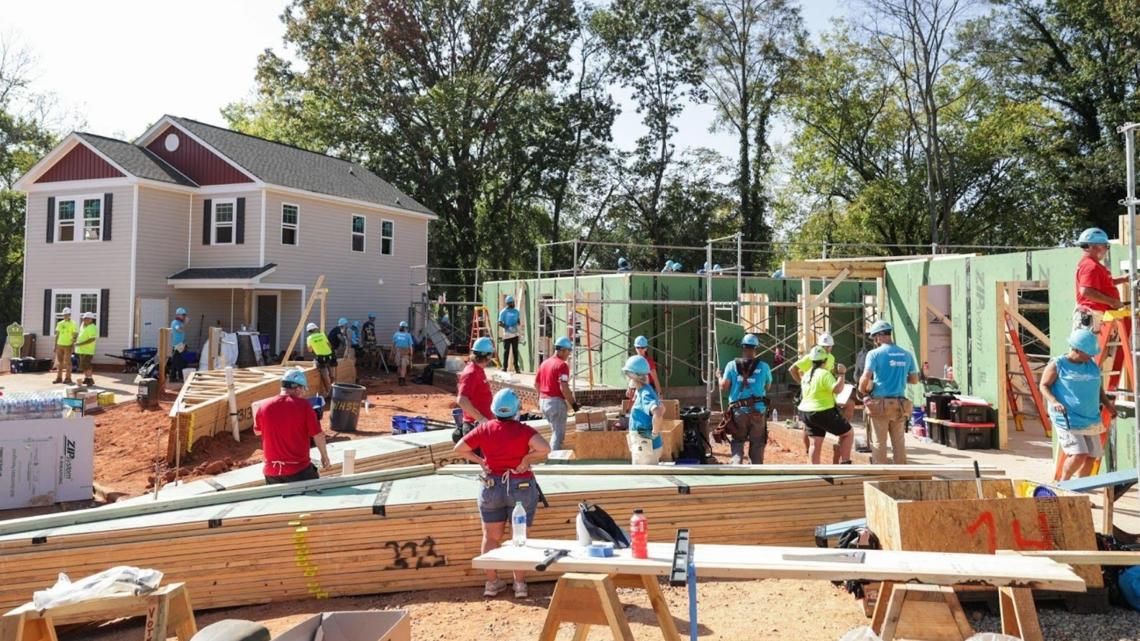
Consider Frank DuPont’s home on Julia Maulden Place, built during the 1987 project. He sold it in 2022 for just under $300,000 and made a hefty profit on the $35,000 he paid for it. The home is appraised for more than $366,000, according to the Mecklenburg County assessor’s office records.
DuPont, 71, said selling the home had its pros and cons. He bought another house with cash and paid some debts.
“Why would I want to move?” DuPont said, while recalling how he loved being close to uptown. “I could be at my church in about six minutes, right on the corner of Davidson and Ninth Street. I can walk to work, walk to my church, walk downtown, walk anywhere I want. I had no reason to move.”
But DuPont felt with new people moving in with larger homes and planning a neighborhood association with new rules on how the front of a home should look, Optimist Park was no longer for him.
Ruby Little says she has no plans to move and hopes to pass wealth to her children when they inherit the home. Other former Habitat homes, including two on Julia Maulden Place and a few along North Caldwell Street, have been sold and replaced with bigger, more expensive homes, townhomes or duplexes.
One home, at 1608 Julia Maulden Place, sold to a family in 1989 for $38,400, according to county deed records. The county records show the family sold the property in 2020 to an investor. The home was razed in 2021 and at the time had an assessed value of $130,500. A new three-story townhome has been built on that same plot and sold in 2022 for $1.3 million, according to the county assessor’s records.
Charlotte Habitat has built some 1,500 homes since 1983. While the vast majority have deed restrictions, it is difficult to say how many have which provisions because the deed restrictions evolved over time, Belcher said.
Belcher added the longer a Habitat homeowner stays in their home, the greater share of the appreciation they can keep.
In October, a new generation of families began logging sweat equity in another part of the city as Habitat resumed construction on another major build — The Meadows at Plato Price. The site — where a former segregation-era school of the same name stood until 1966 — was vacant until the 1980s when the city took it over, later donating it to Habitat.
Kee’a Carroll, a single mother with two teenage girls, was among those helping with the build. After living in an apartment for a decade, Carroll expects to move into a permanent home early next year.
The Observer spoke with Carroll, Little and her daughter Rachel, and DuPont about their experiences with Habitat-built homes.
Growing up Habitat
Rachel Little remembers the positives and negatives growing up in Optimist Park during the late 1980s. Her parents Ruby and Jimmy Little purchased a home in 1988 on North Caldwell with the help of the Habitat program and subsidies for $32,500, according to Mecklenburg County deed records.
The area was a former mill community, but it was close to uptown.
“It was beautiful where they built right in the city. I know then they couldn’t have (known) what it would be now but, it pretty much urbanized the area,” the 37-year-old told the Charlotte Observer. “We were the first set of houses. It kind of set the tone for the area, to be honest.”
Because it was a Habitat community, families were sponsored by churches and other programs, Rachel Little said, noting she remembered being invited to a summer camp and other things.
On one side of her parents’ home, there was a warehouse. Big 18-wheeler trucks used to come in and out of the neighborhood. On the other side, nothing but open land. Across from the home was a set of high-rises and four other homes in front of them.
A variety of nationalities — Cambodians, Vietnamese and others — lived across the street from her parents, she said.
“It was a mixed environment, but around us, it was predominantly white,” Rachel Little said. “We were like the group of Black people, the Black families, so to say.”


Having Habitat created stability, Rachel Little said. She has worked an assortment of jobs, from school teacher to truck driver.
“The vibe of the community was awesome,” says Mark Davis, 60, who volunteered at a local Episcopalian church to help Habitat families during the 1990s. “We used to walk around, from house to house, visiting people. We knew just about everybody on each block. It was awesome. Obviously, that has just changed.”
Little recently moved back home to take better care of her mother, who is ailing. The second-generation homeowner says she’s not phased by the rapid development happening around her beloved neighborhood and doesn’t see it as gentrification. Habitat has always been there for her family and Mecklenburg County and the state help with tax relief programs to offset rising property values.
“My parents and I feel like Habitat was just like the stepping stone ... that keeps on stepping, honestly,” she said. “It’s not what happens, it’s what you do after it’s happened. I’m grateful that some of these areas are finally getting lifted up.”
‘I was speechless’
After Frank DuPont moved into his Habitat home in 1987, he would spend many weekends working in his front yard. One time while puttering with a leaf blower, he saw two black cars circling the cul-de-sac near his corner lot at 19th Street and Julia Maulden Place.
He remembered not knowing anyone with those sleek cars — the kind he’d seen in a motorcade. Must be going to another home, he mused. But the cars pulled up in front of him.
A driver came out and strolled around to open the back passenger side door.
“And Rosalynn Carter (came) out. She started walking down the sidewalk,” DuPont recalled. “I knew her face, and I had to think for a minute: This is the President’s wife coming to visit me?”
It was one of several great moments DuPont and his wife, Diane, experienced while being Habitat homeowners.
The happy encounter with the late First Lady was not his first meeting with her. When the Carters came to build homes in 1987, the DuPonts and others worked alongside the couple, building the homes and their future. This time, the First Lady simply was checking in.
“She said she was just stopping by and, ‘how’s the house coming along?’ and if I needed anything. I was speechless,” he said.
DuPont said he really appreciated Habitat giving a young couple “hope“ — especially since they had very little credit history, he said.
DuPont continued to help build homes for Habitat for the next 13 years, working as a site manager for the nonprofit.
Selling his home helped him financially, but it “absolutely” was not something he was planning to do.
He says Habitat could be more involved in the lives of homeowners after they purchase homes and check in on them, like Rosalynn Carter did. Perhaps the nonprofit could find a way to preserve the community as a Habitat neighborhood forever, so when new families move in, it’s still affordable, he said.
“If man can send this spaceship up there,” he said, referring to when he watched a NASA mission on television, “surely man can figure out a way to save (the) Habitat for Humanity neighborhood. Put the effort into it.”
“What we are doing today aids in keeping homes affordable longer than when we began,” Belcher said in an email.
’I’ve survived worse’
It was denial number three for Kee’a Carroll when her Habitat for Humanity application for a home was rejected last year. With her teenage daughters growing, plus juggling jobs and school, it was uncomfortable, again.
But Carroll was used to being uncomfortable.
Growing up in New York City, she never had a permanent home as her family moved around. She attended four high schools. She steered clear from ever making new friends, knowing she would be at a different school come the next fall.
As an adult, Carroll was running from an abusive relationship when she arrived in Charlotte more than a decade ago. She stayed at a relative’s home. She worked two jobs and hustled to handle everything.
“We slept on a mattress,” that had no frame and was on the floor, she said.
A chance meeting with a neighbor led to connections with Charlotte Family Housing and the apartment she has lived in since 2012. But it was getting harder to manage things, with her daughters, now 14 and 15, needing more space.
Determined to persevere, Carroll, 39, finally is seeing some success. She received notice earlier this year that Habitat approved her application and now is among dozens of families getting new Habitat homes at The Meadows at Plato Price.
“I’ve been working so hard and as a single mother, it’s a struggle every day, to just get up and do the things that you need to do for your children, for yourself,” she said. “To actually have been accepted, I was like wow, if I just don’t give up, that’s it. I come from a strong mother, a strong line of women. And I’m not gonna let it beat me. I’ve survived worse.”

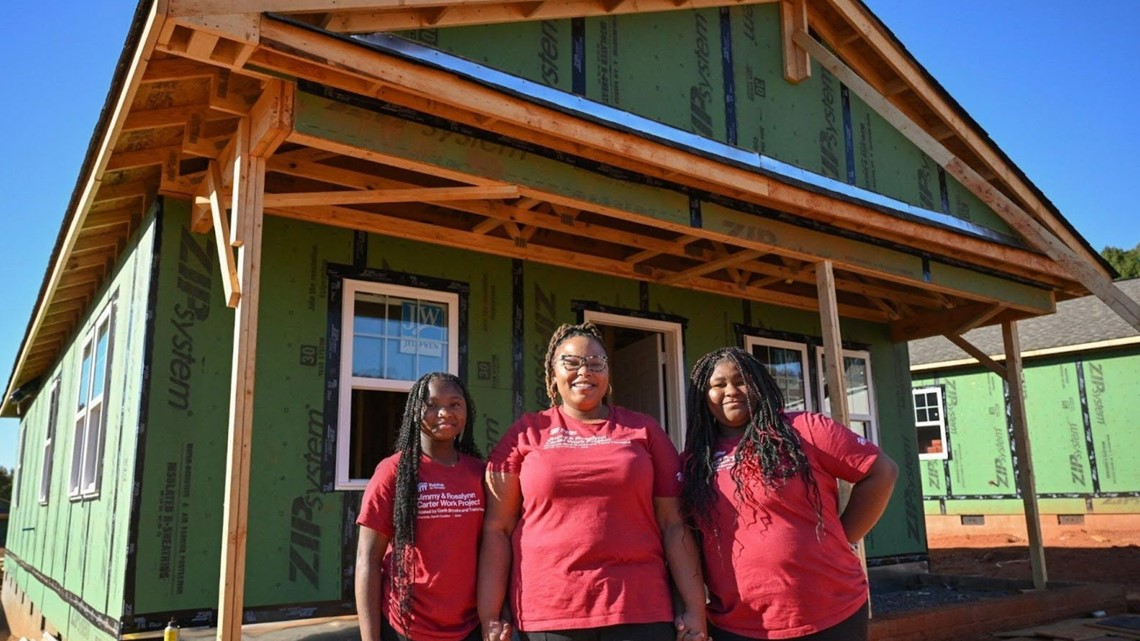
Carroll has been logging sweat equity hours for the better part of a year to earn a plot. Besides the hours to help build the home, Carroll will also do volunteer hours at Habitat’s ReStore shop.
“The resource is really nice because to me it’s (an) upscale Goodwill, in a sense,” Carroll told the Charlotte Observer. “People come in there and they bring furniture and they bring different stuff there, and you just go in and you help set the stuff up. You help customers and stuff, which is pretty simple.”
Finding the three or four hours a week to do that was the greatest challenge. Because she is getting a brand new home, Carroll needed to earn at least 300 hours.
“For me it really didn’t matter, if it was refurbished or if it was brand new, I really didn’t care,” she said. “I just wanted a home.“
Loretta McClure, 82, has lived in her north Charlotte home for more than 60 years; she and her late husband Alfred McClure Jr., raised their eight children there. But after decades of neglect, the ranch-style home had fallen into disrepair.
The floor was sinking, the roof was leaking, and termites had damaged the underlying structure, explained her daughter, Carol Green.


Desperate for assistance, Green, 59, applied to some of the Charlotte-based programs that offer critical home repairs. Habitat for Humanity of the Charlotte Region responded.
Better known for building new homes for low-income families, Habitat Charlotte has made badly needed repairs to 1,075 properties since 2008, the year it launched its critical home repair program.
The program offers repairs to roofing, flooring, heating and cooling, electrical and plumbing – all at no cost to qualified homeowners, says Charles Monroe, director of construction for the Habitat program. It also addresses accessibility needs that some homeowners may have.
The goal is to allow more low-income residents to age safely in their homes without fear of displacement, a growing concern for many as the Charlotte housing market becomes more expensive.
The shift toward more critical home repairs also reflects a growing realization: If Charlotte is to address its affordability issues, it must do more to preserve its current stock of aging homes, not just build new affordable units.
A growing need
From 2014 to 2019, both rental rates and home prices have outpaced income growth in Charlotte, according to a dashboard published by the city in February 2021.
While the median gross rent in Charlotte increased by 34%, the median household income rose by only 24%.
That imbalance has increased the rate of displacement for some of the city’s most vulnerable residents, especially seniors and low-income residents living in historically Black neighborhoods, where rising property values have attracted gentrification and corporate landlords.
To combat the growing threat of gentrification, Habitat Charlotte now requires homeowners under its critical repair program to sign a five-year deed restriction, a practice it began in 2013.
In exchange for the needed repairs, homeowners must commit to certain conditions. For example: If a home is sold within five years after repairs are made at no cost, it must be sold to a low- to moderate-income buyer approved by Habitat.
Monroe says the requirement has been a deterrent to some homeowners whose property values have increased significantly due to recent gentrification in their neighborhoods.
To qualify for Habitat’s repair program, Monroe says, a home’s value cannot exceed $300,000.
In addition to Habitat, several other Charlotte-area programs are working to address displacement through critical home repairs.
The city of Charlotte has a Safe Home Housing Rehabilitation Program, which provides loans to low-income homeowners for home repairs, and the North Carolina Housing Finance Agency finances emergency home repairs for qualified homeowners through its Urgent Repair Program.
As Charlotte’s population and housing stock age, Monroe said he anticipates a greater need for programs that help with critical home repairs.
“Scarily, I have learned that we’re just scratching the surface of the needs,” he said.
Keeping it in the family
Through the Habitat program, the McClures managed to salvage a property with more than 90 years of family history.
In the 1930s, Loretta McClure’s father-in-law, Alfred McClure Sr., bought the plot of land in north Charlotte at a time when neighborhood covenants and racist deed restrictions meant Black families were legally excluded from living in certain parts of the city.
Then some 30 years after his father bought the land, Alfred McClure Jr., Loretta McClure’s husband, built a home there. Inside that three-bedroom, two-bathroom home, the couple raised eight children, including Carol Green.
Eventually, the home fell into disrepair. Green said those problems worsened after her father suffered a massive stroke in 2018.

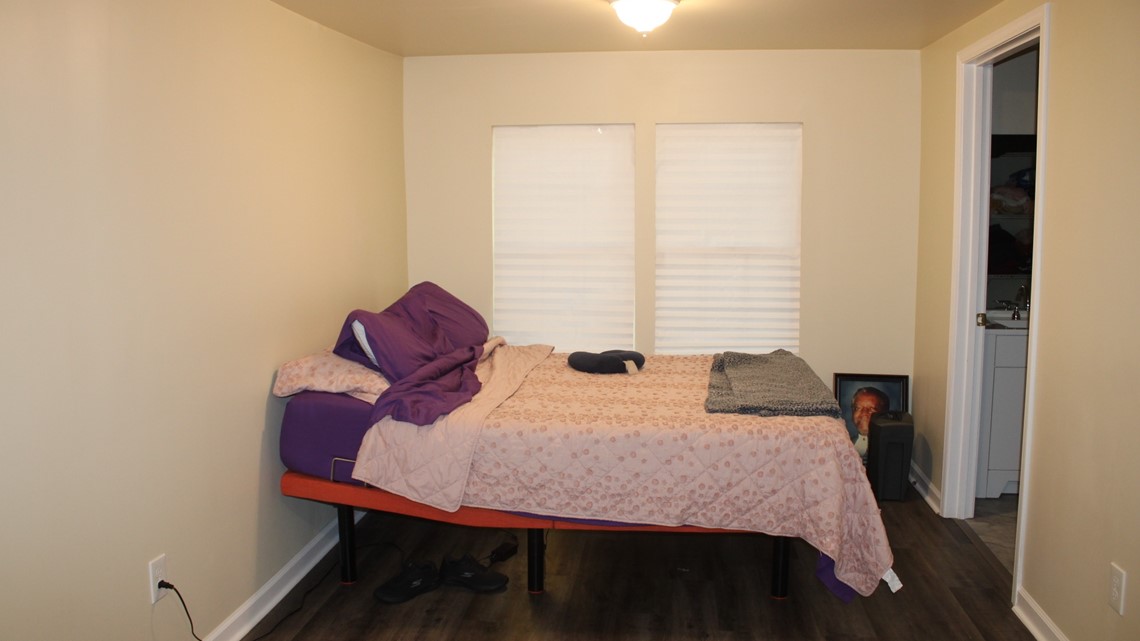
Under the Habitat program, repairs started in December 2022 and lasted until August 2023. The entire house had to be gutted and remodeled, mostly due to termites. The total costs came to about $200,000, Monroe said.
Green said It’s unlikely her family could have managed the repairs on their own, but keeping the house was important to the entire McClure family.
“I was born and raised in this house,” she said.
More importantly, Green wanted her mother, Loretta McClure, who was recently diagnosed with dementia, to continue living in their family home, rather than having her moved to an unfamiliar apartment.
“At the end of the day, this is home for her,” Green said.
Now that the home is restored, Green plans to give the house to her son, Desmond, 35.


Adjusting to needs
Since starting its home repair program, Habitat Charlotte has adjusted its model to fit its client’s needs.
Initially, the program required homeowners to be placed on repayment plans, which averaged $5 to $50 a month.
Monroe described that model as unsustainable.
“It was just a bad model because you got people that are living off of Social Security, and there’s no disposable income,” he said.
In early 2013, repayment plans were revamped to a sliding scale based on income, according to Meghan Manges, a Habitat Charlotte support supervisor. Then in 2019, the organization stopped requiring repayments for families with incomes at or below 30% of the area’s median income, or AMI.
These past attempts to adjust repayment measures eased the financial burden for families, but they did not eradicate it. So, at the start of 2023, all repayment requirements were eliminated, including for homeowners on repayment plans.
According to Monroe, the average homeowner applying for critical home repairs is about 60 years old, and many have chronic illnesses, such as diabetes or cancer.
Most of the homes being repaired are about 60 years old, and the average cost of repairs totals about $60,000, Monroe said, adding that repair costs have nearly doubled since the Covid pandemic.
The program is funded by community development block grants from the federal Department of Housing and Urban Development (HUD), the city of Charlotte and Mecklenburg County.
For fiscal year 2023, which ended June 30, the program helped 130 homeowners stay in their homes, Monroe said. The year before, the program made repairs to 136 homes.
Despite the program’s success, Monroe said the need in Charlotte remains great.
Comparing models
While Habitat Charlotte tackles displacement on an individual level, other local nonprofits, such as Rebuilding Together of Greater Charlotte, seek to combat gentrification and displacement on a community level.
Since launching its Building a Healthy Neighborhood program in 2018, the organization has repaired about 20 homes in the Camp Greene/Enderly Park neighborhoods in west Charlotte, said Beth Morrison, executive director of Rebuilding Together of Greater Charlotte.
Similar to the Habitat program, it offers critical home repairs at no cost to homeowners, and it requires homeowners to sign a five-year lien.
To identify neighborhoods and homes in need of repair, the program uses community outreach, sending out postcards and attending community meetings.
Morrison said the outreach is not only crucial for finding neighborhoods in need but also for building trust with community residents, who may be hesitant to work with the nonprofit.
“It can really sound too good to be true for an organization that somebody might not have heard of before to say, ‘We will put $30,000 into your home in repairs and you don’t have to pay anything; it’s free,’” Morrison said.
In addition to home repairs, the program also invests in community-wide projects, like pavilions and walking trails.
Most recently, the program began work in its fourth Charlotte neighborhood, starting community conversations in the Hidden Valley community in March 2022.
So far, about 43 Hidden Valley homes have been approved for repairs, and work has been completed on 30, Morrison said. A second round of repairs will begin when work is completed on the first 43 homes.
Some of the community projects in Hidden Valley include building a seating area and painting a mural at Hidden Valley Elementary.
The cost to repair a home in Hidden Valley has averaged between $20,000 and $30,000, Morrison said, noting the impact of inflation.
Rebuilding Together of Greater Charlotte is funded through several government programs, including HUD, the city of Charlotte and corporate partners like Wells Fargo.
Once finished in Hidden Valley, Morrison said, the nonprofit will expand its work into east Charlotte neighborhoods.
Who qualifies?
Habitat Charlotte’s current requirements include:
- Household income must meet income requirements
- The home must be a detached, single-family
- Applicants must have owned the property for at least 5 years and be currently living in the home
Building a Healthy Neighborhood requirements include:
- Household income at or below 80% of AMI, or just below $56,000 for a single individual
- Home must need critical repairs
- Home must be occupied by owner
- Homeowners must be in good financial standing, such as being on a payment plan if behind on taxes or mortgage payments
Earlier this year, Yesenia Rios moved into her first home, a three-bedroom house in Kannapolis.
The atmosphere on moving day felt a bit like a block party. Parked cars lined the street and dozens of people, from elected officials to church leaders, gathered in her front yard to celebrate.
This day came after years of work, marked by ups and downs.
“Five years ago, I moved from New York looking for a new start for me and my children. I’ve been moving for the last five years from place to place. This will be my fifth time moving, and this will be the last,” she told the crowd.

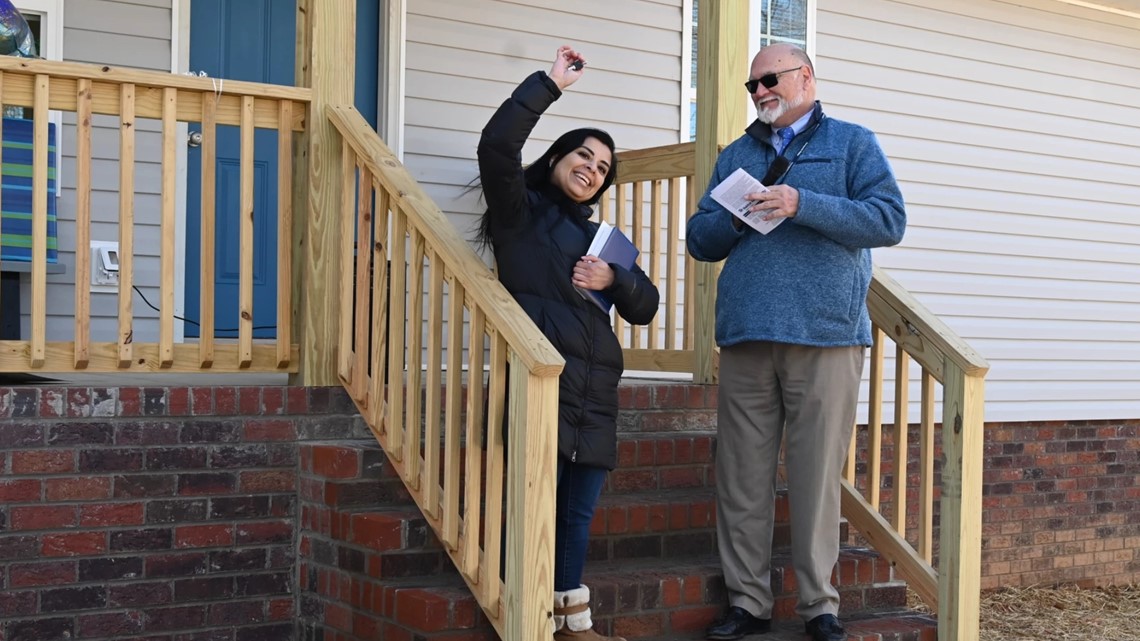
Rios is one of three heads of household to become a homeowner this year through Habitat for Humanity in Cabarrus County, north of Charlotte. To qualify, she put in about 250 work hours and helped build the house with other Habitat volunteers.
She explained in a phone interview that Habitat was her pathway to achieving stability and affordable homeownership.
“When I moved to this state, things got complicated for me. I ended up in a Christian shelter,” she said.
She met Habitat volunteers at the shelter, which had a housing program, and began her journey to becoming a homeowner.
Young, rapidly growing demographic
Rios, who was born in the United States and grew up in Mexico, made homeownership a priority. And in many ways, she represents the future of the home-buying market.
Over the next 20 years, Latinos are forecast to represent the bulk of new homebuyers in the U.S., despite persisting economic and structural barriers. That’s what researcher Jun Zhu and her colleagues at the Urban Institute in Washington, D.C., found.
“Between 2020 and 2040, if you’re talking about the homeownership increase, 70% of the new net homeowners are actually Hispanic,” Zhu said. “This is a big deal.”
Latinos are the fastest-growing demographic in North Carolina and the U.S. and they’re a younger demographic, which means more of them are entering their peak years for home buying.
“They are younger. They have less income and wealth. And if we do the comparison for the credit score, they have a little bit lower credit score,” Zhu said. “But family size. [They have] large family sizes, and the majority of them actually live in a multigeneration family. So that’s very unique to Hispanics.”
Mercedes Dockery has worked as a real estate agent in the Charlotte area for the past seven years. She says around 90% of her clients are Latino.
“They are looking for land. They love to have land and to be spaced out from other houses,” she said.
That can mean leaving Charlotte, where the affordable housing market is limited. Many of Dockery’s clients are looking at places like Monroe, Gastonia or Fort Mill.
UNC Charlotte found that only 3.8% of the homes sold in Charlotte last year were valued under $150,000. (That’s a little under the value of Rios’ new home in Kannapolis). About 25% were valued under $300,000.
Securing a mortgage for under $150,000 can be difficult, said Tara Roche of Pew Trust’s home financing project. She says the lack of access to lower-value mortgages is an issue leading certain homebuyers to explore alternative financing, like land contracts or rent-to-own agreements.
“Black, Hispanic and Indigenous families, and some households in rural geographies, have lower levels of mortgage lending and higher levels of alternative financing,” Roche said.
“Alternative financing arrangements can come with greater risks and higher costs for people who are on their pathway to homeownership.”
The demographic most likely to use alternative financing was Latino buyers. Pew Trusts found that 34% of Latino homebuyers had used alternative financing, compared to 23% of Black homebuyers and 19% of white homebuyers.
“For people who are using land contracts, for example, they don’t get the deed upfront, so that means they can’t tap into any of the equity that would be built in the home the way you could if you were a mortgage holder,” Roche said. “You’re at increased risk of foreclosure or eviction because you don’t hold (the) title to that home.”
Urban Institute researcher Todd Hill explains that structural barriers continue to depress homeownership rates in communities of color.
“Much like what we’ve seen with Black homeownership initiatives and marginalized communities and communities of color that attempt to pursue homeownership, you still have a number of systemic and historical policies that have been in place that have impacted the ability for these particular communities to access credit and pursue homeownership.
“You still have a trust deficit that exists with the Hispanic community, with (the) African American community and other communities that have traditionally been sort of locked out of homeownership opportunities,” Hill said.
Analysis by Construction Coverage identified a 26% gap in the homeownership rate between whites and people of color who are homeowners in the Charlotte metro area. That’s a few percentage points higher than the nationwide gap of 22.3%. Even with the forecast growth in Latino home buying, this gap isn’t expected to narrow by much in the coming decades.
To encourage sustainable homeownership, Hill says there’s a need to educate prospective buyers about their financing options. He says there are more than 2,500 down-payment assistance programs nationwide.
“I think really one of the factors is housing counseling. When you look at, for example, the ability for a counselor to navigate the mortgage process, they can help to build knowledge and confidence in the home buying process,” he said. “A counselor can also assist in case of language barriers.”
Roche said she would also like to see alternative financing recognized on a policy level, to protect buyers from losing their investments.
Habitat for Humanity International was established in 1976 with the idea of using partnerships and volunteers to help build homes for those in need. Since its inception, the nonprofit has helped more than 39 million families build safe, stable housing in an effort to create generational wealth in low-income families.
Among those marginalized groups who are disproportionately impacted by the lack of affordable housing are LGBTQ+ people.
According to studies provided by the Human Rights Campaign, over 22 percent of LGBTQ+ identifying people live in poverty compared to 16 percent of heterosexual, cisgender people. To break it down further, almost 30 percent of trans people and cisgender bisexual women, 19.5 of percent cisgender bisexual men, almost 18 percent of cisgender lesbian women and 12 percent of cisgender gay men live below the poverty line.
Discrimination could account for why queer-identifying people have a hard time finding affordable housing. In North Carolina, specifically, there isn’t a statewide law prohibiting discrimination on the basis of sexual orientation, but individual municipalities can elect to pass their own non-discrimination ordinances if they so choose.
Habitat for Humanity in Charlotte has played an integral role in creating affordable housing options across the city, with over 4,000 families in the city receiving help from the local Habitat.
One of the builds from 2016 aimed to partner with a local LGBTQ+ organization known as the Plus Collective — then called the Charlotte Lesbian and Gay Fund — to build a home for a mother of four in the Lincoln Heights neighborhood.
Since then, the Charlotte Habitat has yet to complete another Pride building project. However, other Habitats across the state have started and continued Pride builds, utilizing partnership models similar to the one between the Lesbian and Gay Fund and Charlotte’s Habitat.
The 2016 Rainbow build
Charlotte’s Habitat for Humanity partnered with the Lesbian and Gay Fund, who pledged $5,000 towards building a home, to bring volunteers from all backgrounds to help build a residential structure. Former Habitat for Humanity employee Bettie Coltrane said in 2016 the Pride Build signified two differing groups coming together.
“I’ve seen it over and over at Habitat and where two very diverse people come together on a build, and when you are working on the same goal, it tends to bring people together rather than highlight their differences,” she explained.
At the time of the Charlotte Rainbow Build, HB2 was at the forefront of the North Carolina political climate. Habitat for Humanity is a Christian, faith-based organization, which has a very different background than most organizations who work with LGBTQ+ folks.
Jeremy Hall is the Director of Development at Charlotte’s Habitat, and at the time of the 2016 build, he was with both Habitat and the Lesbian and Gay Fund. He said he felt it was important for Habitat to step up and take on Pride-centric projects, especially given its reputation as a faith-based organization.
“We wanted to say very clearly that we stand with our LGBTQ+ community and we want to help them find home and stability and affordable living,” he explained to Qnotes. “[We felt] participating in a rainbow build will help to dismantle some of those belief systems that keep people from getting involved.”
Linda Lawyer, who volunteered with the Lesbian and Gay Fund, called the build a “Rainbow Build,” as a direct tie-in to the community it was meant to serve.
“They want to bring in the gay and lesbian community to help build this house,” Lawyer said to Spectrum News. “It shows that we can work together — we really want to work with everybody, and what’s better than building a house?”
There’s a reason Charlotte’s Habitat for Humanity hasn’t completed another Pride-centric project since the Rainbow Build in 2016. Hall confirms it was able to happen because the Lesbian and Gay Fund provided the $5,000 grant and since then, there hasn’t been an organization who has taken up the initiative.
However, if an organization would be willing to partner with Habitat for a Pride building project, Hall said it would help reopen the doors to doing another Rainbow Build.
“If we found the right community partner, we could certainly move back in that direction, but I think it doesn’t make much sense without some kind of community partnership,” he explained. “All of our partners are supporting really great things in the community, but the only reason right now we don’t have an active partnership for a Rainbow Build is because the right community partner has to help us get there.”
Qnotes reached out to the Plus Collective, asking for information regarding the 2016 build. A spokesperson from the Plus Collective stated the organization was approached by Habitat in 2016 regarding the Rainbow Build, stating the following:
“It sounds like when we were presented with the opportunity to participate in the build, we were unable to provide volunteers on short notice to do so. Additionally, Habitat did not collect [information on] whether the family identified with the LGBTQ+ community as it was a potential prohibited basis from a fair lending perspective — therefore, we don’t know if the family aligned with our organization or not.”
Other Pride builds across the state
While there isn’t much information on Charlotte’s Rainbow Build, other Habitat chapters elected to start their own Pride build initiatives. Wake County’s Habitat for Humanity built a home on June 9 this year in partnership with Enact and the LGBT Center of Raleigh as a way to “support inclusive, affordable housing,” for queer people.
Raleigh’s Pride Build took place in a Habitat build neighborhood called Old Poole Place, which is located off of Old Poole Road in Raleigh. Once the neighborhood is completed, it will be an entirely Habitat-built community with a mix of single family homes and townhomes. Habitat also plans to connect the neighborhood to public transportation systems including GoRaleigh stations and bus routes in an effort to connect the neighborhood to the rest of the city.

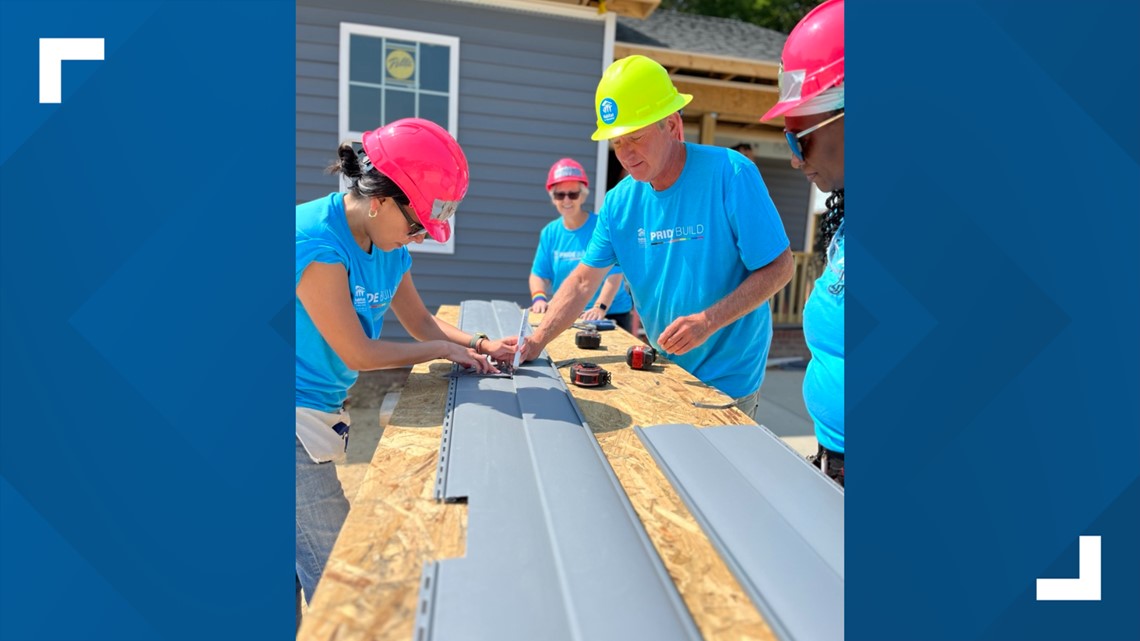
“Habitat’s mission is to bring people together to build homes, communities and hope and that’s every Habitat’s mission,” Olivia Bawler of Habitat for Humanity Wake County told Qnotes. “How we interpret that mission … can vary, but for us here in Wake County, we’re particularly in the seat of the state government and so we do a lot [of] advocating for policy change that helps people across the continuum access housing, and that’s not accessible to everyone right now.
“So we try to influence those other kinds of ends of the spectrum.”
Lindsey Halliday and her partner Bea — who’ve been together for over 15 years — worked alongside over 70 volunteers, building the first home the two ever owned for this year’s Pride build.
“There’s not a lot of laws protecting discrimination. You can get evicted just for being trans (or) just for being gay,” Lindsey explained in June.
Bea, who is transitioning, expressed the couple was always concerned about their landlords discovering her and Lindsey’s relationship.
“I don’t think our landlord knows anything about us and that’s really for the best,” said Bea. “It’s terrifying knowing at any moment I can lose my job and lose my house with no notice because there’s nothing protecting me here.”
Bawler said the Pride build came about two years ago after Wake County’s Habitat talked to other chapters across the country about what they were doing to address affordable housing concerns in the LGBTQ+ community.
“Working with other organizations who are doing either similar work or working with organizations who have subject matter expertise, like the LGBT Center in Raleigh, are ways that we can kind of extend our reach and have more impact together,” she explained.

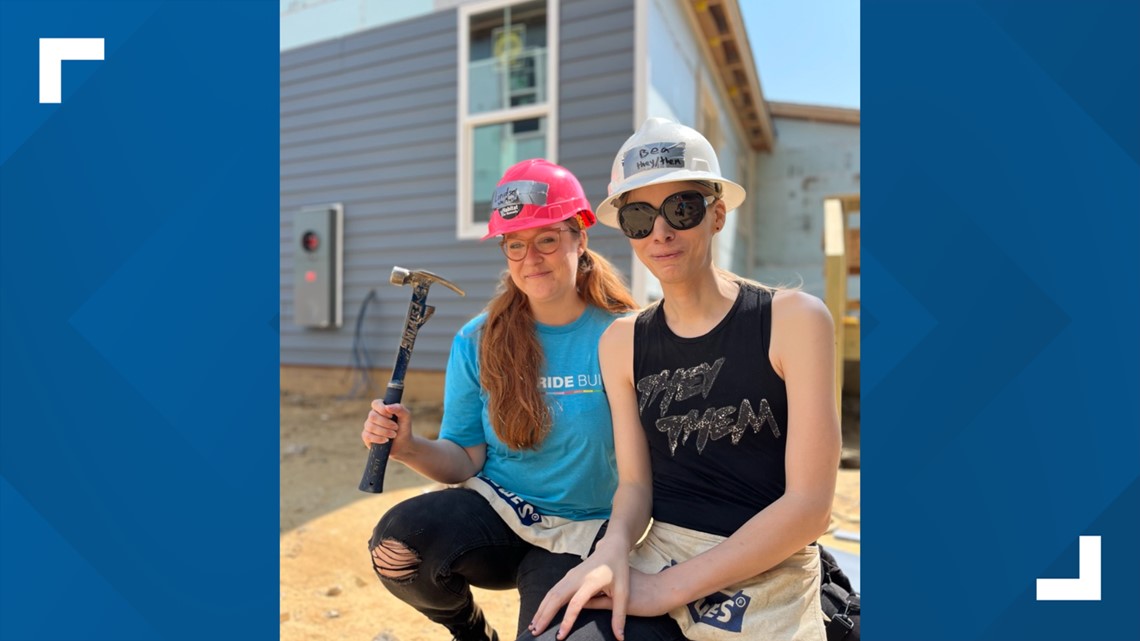
Wake County’s Habitat wasn’t the only one in the Triangle holding Pride builds — Durham’s Habitat partnered with Gays 4 Good, a LGBTQ+ volunteer organization, to have its own Pride build on June 3. In addition, the Orange County Habitat for Humanity established a new initiative called Building Pride, which aims to “focus on the unique issues faced by LGBTQIA+ and more specifically, trans and gender-nonconforming people.”
The Wake County Habitat chapter has worked to reach out to members of the queer community through various outreach efforts, including attending Out! Raleigh on June 24 with the LGBT Center of Raleigh. Bawler said she hopes through these outreach opportunities, the Wake County Habitat can expand its Pride build year after year.
“We have more room to engage other local LGBTQ organizations, particularly being in the seat of the state government,” she explained. “I think there’s several statewide organizations that we’ve started to work with, including Harmony (NC LGBT+ Chamber of Commerce), for example.
“So we have the benefit of accessing statewide organizations in addition to local organizations, and I think that gives us an opportunity to make it bigger, to raise more money and to raise more awareness for this particular need for affordable housing.”
Could Pride Build initiatives be replicated?
The short answer to the question is yes, but the long answer is more complicated.
The original Rainbow Build in 2016 required partnerships with community organizations, and other Habitat LGBTQ+ Pride initiatives have been driven through partnerships. Bawler said Wake County’s program wouldn’t have been made possible without the partnership the Habitat has with the LGBT Center. Education is also an important factor in Habitat’s mission, so Bawler said in order for initiatives like Pride Builds to be successful, they must aim to educate LGBTQ+ folks about homeownership and affordable housing.
“For us, community outreach has looked like primarily participating in events that are targeting the audience that we’re hoping to also target with our homeownership and home preservation programs — so that might be participating in that rally or it might be interacting with the business community,” she explained.
“We’d encourage any Habitat who’s interested to start their own Pride Build. Starting to build relationships in the community is an essential first step, and it continues to be something that we hope to grow in as we continue to grow Pride Build itself.

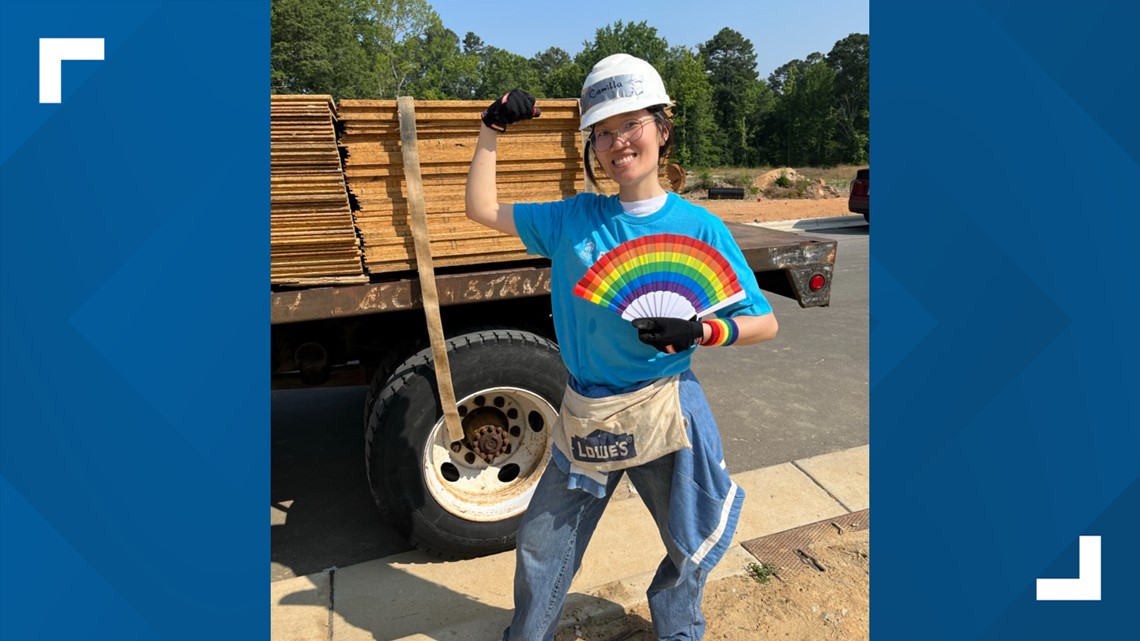
“I think for any Habitat looking to start a build like this, I would say start with key community relationships.”
Hall said he hopes for the Rainbow Build to return one day in partnership with LGBTQ+ advocacy groups in the Charlotte area.
“There’s some things that straight couples have that makes it easier for them to have access to equity and affordable homes,” he explained. “There’s just such a need there and I thought it’d be a great way to show up in the housing space … [when] the day comes we find the right community partnership, I would personally love to pick this project back up.”
During the 2023 Local News Impact Summit, presented by the Charlotte Journalism Collaborative, housing advocates, community leaders, nonprofit organizations and local journalists focused on current trends in affordable housing and the potential solutions that exist.
During the summit, Charlotte’s affordable housing leaders posed the question, can Charlotte use 3D printing?
These days, the technology behind 3D printing is being tapped to create more affordable housing.
In 2021, a Virginia family got the keys to Habitat for Humanity’s first 3D-printed home in the nation, and now they’re building two more.

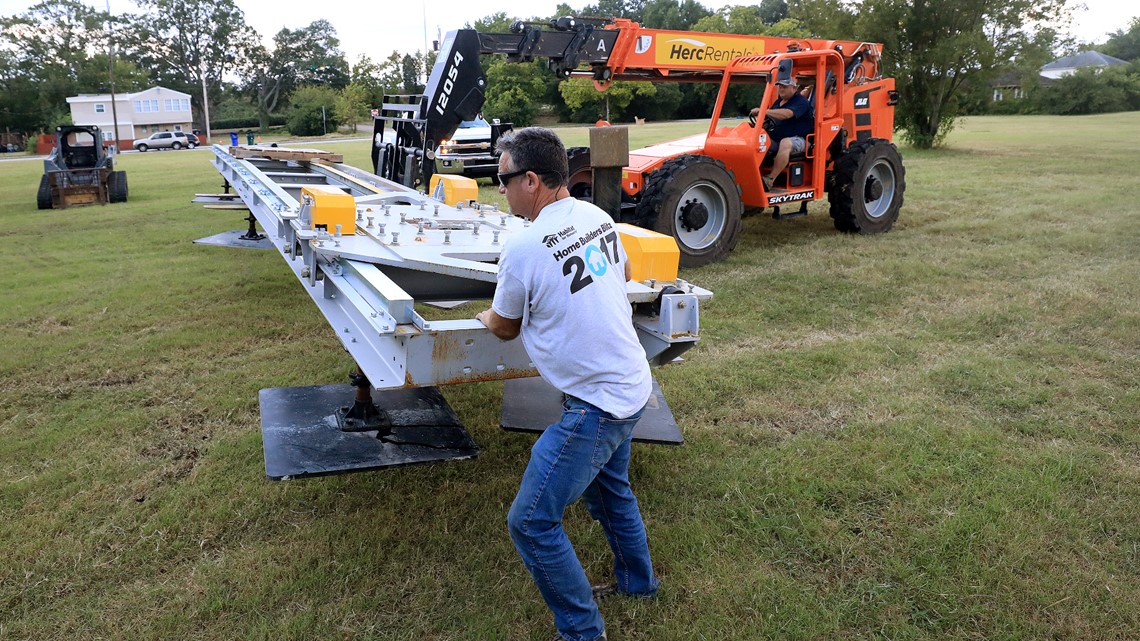
Their goal is to use the technology to make building quicker and cheaper.
“If we can build faster, we can create more affordable housing for these families with low to moderate income,” Janet V. Green, CEO of Habitat for Humanity Peninsula and Greater Williamsburg in Virginia, said.
The 3D printer looks like a giant robot. It builds the wall system of a home with a concrete mixture. Traditional construction is used for other things like the roof, wiring, and plumbing.
Green said printing the walls is faster than wood framing.
“We think this reduced our standard construction schedule by at least four weeks using this innovative technology,” Green said.


WCNC Charlotte’s Lexi Wilson went to Bob Glusenkamp, senior VP of construction operations for Habitat for Humanity of the Charlotte Region, to see if this could be a solution to adding more affordable housing in Charlotte.
“One of the big challenges is that not all of the code officials have been exposed to it yet, so it’s not really in our North Carolina building code,” Glusenkamp said.
He said like any new building material or building technology, people in the industry have to get used to it and right now, it’s still new — and printers of this size are few and far between. But there’s hope one day, 3D printing will become mainstream in Charlotte.
“I think it will be part of the future of all Habitat affiliates in the U.S., it just needs to get more affordable and produce at a large enough scale that we can all use it,” Glusenkamp said.

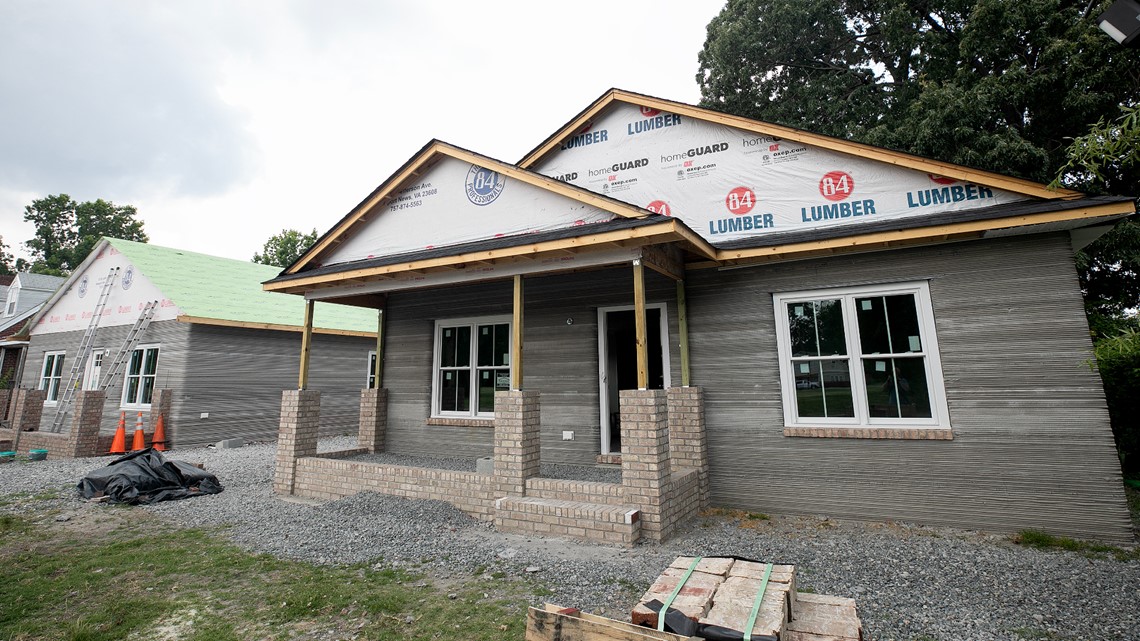
Right now, there is also a labor shortage of construction workers. Green said adding 3D printing as another tool for creating housing opens the door for the next generation to get involved in construction.
“I like to say my grandson has no desire to work in the construction industry but he’s good with technology, so he was very interested in this,” Green said. “So we are hoping this gets people more involved in the labor force of how to build homes differently.”
See more of this story at https://bit.ly/Habitat3D.
When Hurricane Dorian hit the Outer Banks in early September 2019, Ocracoke, a small unbridged island in Hyde County, bore the brunt of the impact. The storm destroyed 40 homes and damaged hundreds more, leaving 400 of the island’s 1,000 residents homeless.
Long before Dorian hit, Ocracoke Island, known for its long sandy beaches and natural attractions, had been grappling with an affordable housing shortage for its almost 1,000 year-round residents. “It just became a crisis level,” said Sara Teaster who moved to the island 10 days after the hurricane.
The COVID-19 pandemic exacerbated the housing crisis on Ocracoke Island, a popular tourist destination, and the population can reach 10,000 people a day during peak season. Remote workers flooded the island, and property owners, some seeking to recoup storm repair expenses, converted year-round rentals into weekly ones.
This has left residents like Teaster, who’s been searching for a new rental for the past six months, struggling to find affordable housing. “It’s incredibly stressful,” said Teaster, whose landlord is moving back to the island. “I’m very embedded in this community and I don’t want to leave, but it’s very hard to find a place to live.”
Mainland Hyde County faces similar struggles, including aging housing and limited rental options.
In the 2022 fiscal year, Habitat for Humanity local affiliates in North Carolina built 229 new homes and repaired 560, according to data provided by Habitat. None were in Hyde County, which is one of 24 counties in the state without a local affiliate.
Across North Carolina, there is a growing need for affordable housing models such as Habitat as home prices increase and incomes remain stagnant.
Could more Habitat for Humanity affiliates help?
Since opening its first North Carolina affiliate in Asheville in 1983, Habitat has built more than 8,000 new houses in the state, according to Habitat. North Carolina boasts the third-highest number of Habitat homes built in the U.S., behind Texas and Florida.
Habitat offers one of the few pathways to homeownership for families earning below 80% of the Area Median Income. For families at or below 50% of AMI, it is the only option.
Driving through the island, Teaster is frustrated by the vacant houses that line the streets, some gutted, others in need of repairs. “It’s really hard to drive past these vacant houses that … have been partially gutted or somewhat still need repairs, but maybe the owners don’t have the money to do it or … they don’t have the time or they don’t live here,” she said. “But if there was a community build group —like the way Habitat does— we could maybe get some of these houses fixed and put people in them.”
Ocracoke needs year-round housing for all essential workers, but the greatest need is for rents between $650 and $1,000 per month, according to a report last year from Development Finance Initiative, an arm of the University of North Carolina Chapel Hill’s School of Government. The median rent on the island is $1,100 per month, and median house sales are $445,000, according to the report.
Since the median household income for a family of four in Hyde County is $58,000, the report found that all Ocracoke essential workers earn less than 100% of the area median income.
The lack of large, contiguous land parcels in Ocracoke makes single-family homes a more practical option than multifamily structures like large apartment complexes. Habitat, with its experience in building such homes, could play a key role in addressing this housing need.
“I know part of Habitat’s model is to help people own their own homes,” said Teaster, who is also a member of Hyde County Educational Foundation, a new nonprofit that is constructing six affordable housing units for new Hyde County School teachers. “Owning a home is very important to establishing long-term community members, so you don’t get transient population. How do you have someone that’s invested in the community? Homeownership is a big part of that, and I know that’s how Habitat helps a lot of people.”
While groups like Habitat cannot alone address Hyde County’s shortage of affordable housing, they can play a crucial role in complementing other efforts including local government initiatives.
For now, the dream of homeownership feels increasingly out of reach for many like Teaster. “Homeownership, at least here on the island, is unattainable for someone like me,” Teaster said. “I have a good job. I have a good income, but it’s not enough to where I could buy a house.”
'I feel empowered'
Heather Witt applied for a home, though hesitantly, after learning on Facebook that the Transylvania Habitat for Humanity was accepting applications. She didn’t think she’d qualify.
Witt had been living in a two-bedroom government-subsidized apartment with her two kids in Brevard. They were growing up and she needed space.
But in September, she moved with her two children to a three-bedroom house under an agreement with Transylvania Habitat for Humanity that requires Witt to make monthly house payments capped at 30% of her income (approximately $1,080) and contribute a total of 200 hours of “sweat equity.”
“It feels amazing, and I feel empowered that this is mine,” said Witt, who volunteered at the organization’s ReStore thrift outlet. “I can paint the walls whatever color I want for my kids, and I can write little notches from where they’re growing every couple of months on my wall. I can plant whatever I want. It’s empowering, it’s freeing.”
This year, Transylvania Habitat for Humanity is poised to complete its 77th home since its founding in 1984. Historically, the organization, which is based in Brevard, built one or two homes annually, but production increased to four homes in 2022 and five homes in 2023.
“It’s such a huge problem that there is no way we could build enough homes to fill the gap completely,” said Angie Hunter, who has served as the organization’s executive director since October 2019.
In Transylvania County, 22% or 3,046, households are cost-burdened, according to North Carolina Housing Coalition— 41% are renters and 18% are homeowners.
About 800 low-to-moderate-income Transylvania families are in need of housing, according to a July report from DFI. Nearly half of Transylvania’s workforce is employed in industries such as retail, earning an average of less than $40,000 per year, according to the report.
The median price of a newly constructed single-family home more than doubled between 2016 and 2022, reaching $633,000. In July 2021, a household needed to earn $77,000 to afford a home in Transylvania County. Today, a household income of $133,000 is needed to afford a home, representing 170% of the area median income (AMI) for a family of four.
High housing costs in Brevard force many essential workers, including teachers, police officers, and home health aides, to commute in from outside the city. Over half of Brevard’s commuters, about 700 people, earn less than $40,000 annually, falling below 80% of the area median income. Many were once residents of Brevard who were forced out due to rising housing costs.
The organization’s new “critical home repair” program, launched this year, will help low- to moderate-income residents maintain their homes, and will expand the organization’s reach within the county. So far, they have completed 57 repairs, said Hunter.
Over the past few years, Transylvania Habitat for Humanity has grown its staff to 18, which has helped increase the number of houses it builds. “What we’re doing is trying to build our capacity to build more homes. We’ve increased our staff, our fundraising, and the number of clients. We couldn’t have ever done that type of production without growing our staff,” said Hunter.
The organization has recently acquired an 8.1-acre property near Brevard, where it plans to build 33 affordable homes.
“If asked what keeps me up at night, my response would be the speed in which we can build homes,” Hunter said. “We want to provide these families and individuals with housing solutions at a much faster pace because the crisis has never been more acute.”
Managing local Habitat affiliates
Establishing local Habitat affiliates is not without difficulties. Each affiliate operates independently, functioning as a construction company, retail store, mortgage underwriter and servicer.
All the original members of the Alexander Habitat for Humanity quit, soon after they hired Matt Cooksey in 2002 as the executive director of the organization.
“They did a good job, but they were exhausted afterward because they did most of the work themselves,” said Cooksey, whose organization has built 28 homes since 2002. They didn’t know how to do the fundraising and all other parts of it, so they ended up hiring me.”
For his first six years, Cooksey was the sole employee, managing all aspects of the organization without any support staff. Today, he leads a team of roughly five part-time employees on the Habitat side and 10 on the ReStore side.
Unlike larger affiliates, Cooksey often manages the entire process for applicants, from initial contact to closing the house. This includes financial paperwork, legal work and even construction. While some tasks are now delegated, like office administration and ReStore operations, he is still actively involved in construction alongside a small team.
As a rural affiliate, Cooksey said donations are hard to come by. In his 21 years, the largest donation his affiliate has received is $1,500, a stark contrast to millions received by some urban counterparts. Part of the reason, Cooksey said, is that large corporations tend to be located in urban areas. This past February, Bank of America, Lowe’s, and Wells Fargo donated $1 million each to Habitat Charlotte Region to help celebrate its 40th anniversary and support the Jimmy & Rosalynn Carter Work Project. The bank also has a team of volunteers who participate in Habitat Charlotte Region’s homebuilding projects.
“If you’re a company, are you going to be headquartered in a small rural county or are you going to be in a big urban area,” asked Cooksey. “Most of the time they give money where their headquarters is and so we don’t get that here.”
In Alexander County, which is just north of Hickory, 17% of households struggle with housing costs, with renters accounting for 33% and homeowners 14%, according to a North Carolina Housing report. This statistic is a constant reminder of the challenge ahead, said Cooksey, noting the increased demand for Habitat houses.
On a recent Saturday, Cooksey was hanging a drywall with a group of high school students from a nearby school. “This house we just were working on I laid all the corners myself and then high school kids came in and they did the rest of it.”
These stories are a part of ‘I Can’t Afford to Live Here,’ a collaborative reporting project focused on solutions to the affordable housing crisis in Charlotte.
WCNC Charlotte is part of the Charlotte Journalism Collaborative (CJC), launched by the Solutions Journalism Network with funding from the Knight Foundation. The CJC strengthens the local news ecosystem and increases opportunities for engagement. It is supported by a combination of local and national grants and sponsorships. For more information, visit charlottejournalism.org.
WCNC Charlotte is committed to reporting on the many issues facing the communities we serve. We tell the stories of people working to solve persistent social problems. We examine how problems can be solved or addressed to improve the quality of life and make a positive difference. WCNC Charlotte is seeking solutions for you. Send your tips or questions to newstips@wcnc.com.



